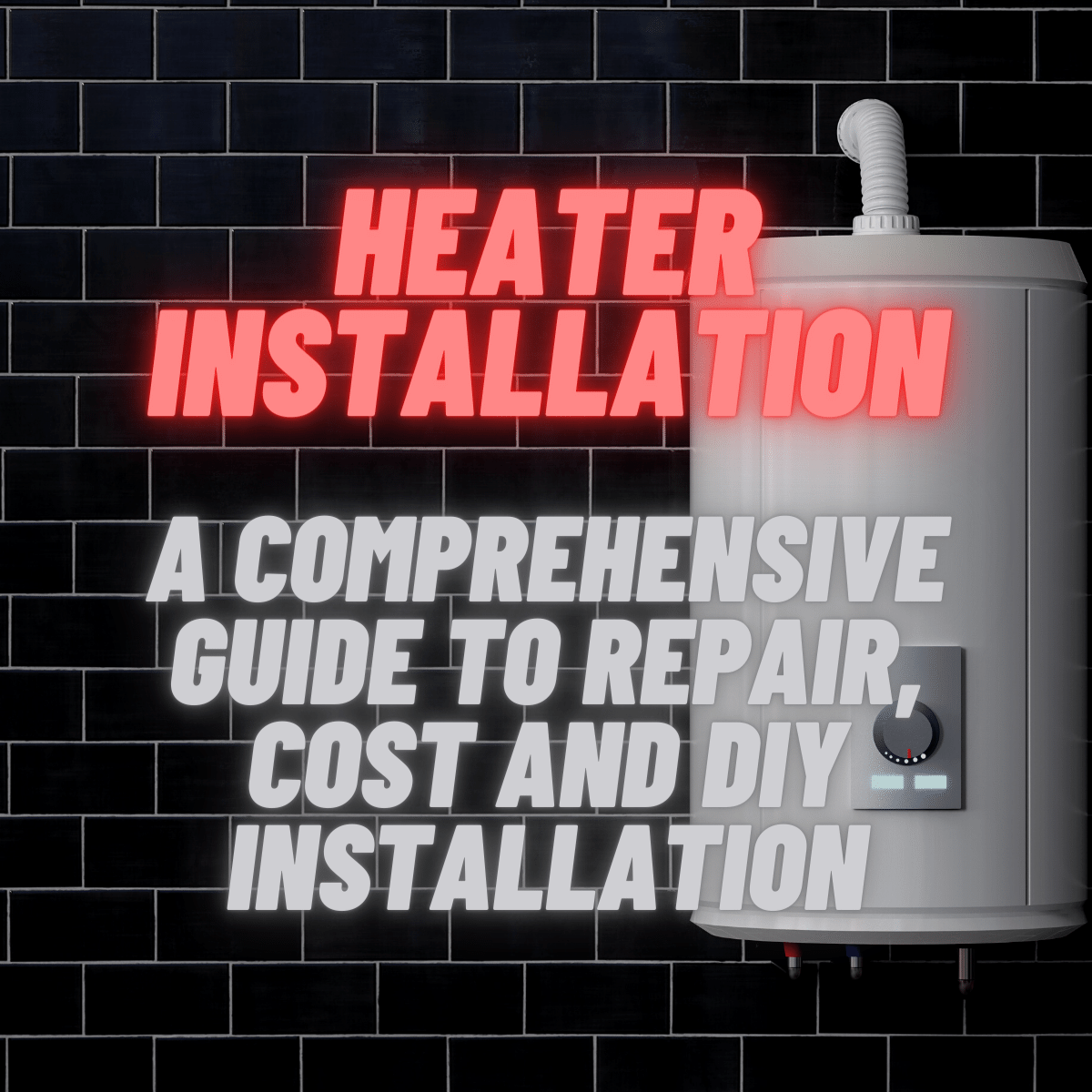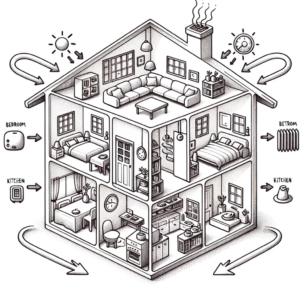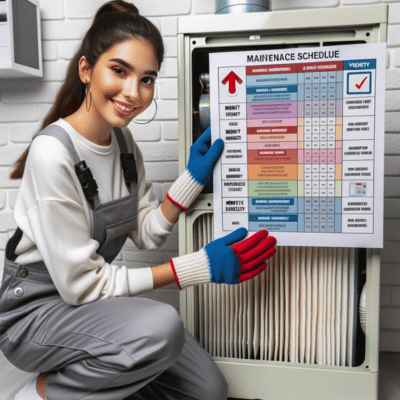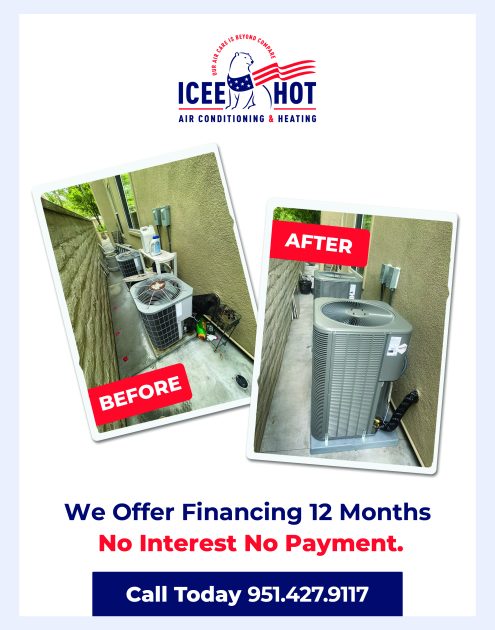
Heater Installation: A Comprehensive Guide to Repair, Cost and DIY Installation
Are you feeling the chill? Don’t let the cold weather get the better of you—invest in a reliable and efficient heating system for your home. But with so many options available, how do you choose the right heater and ensure proper heater installation? Fear not, we’ve got you covered. In this comprehensive guide, we will walk you through the process of selecting the right heater, preparing for heater installation, and maintaining your heating system for optimal performance and longevity.
Whether you’re a DIY enthusiast or prefer to leave it to the professionals, this guide has something for everyone. From the different types of heaters to step-by-step heater installation instructions and cost-saving tips, you’ll have all the information you need to make informed decisions about your home’s heating system.
Key Takeaways
- Choose the right heater for your home based on fuel type, efficiency, size and installation considerations.
- Professional preparation is essential to successful heater installation. Local regulations must be followed.
- Regular maintenance and professional repair services are necessary for efficient functioning of a water heater. Compare quotes to save money.
Choosing the Right Heater for Your Home

Maintaining a comfortable living environment and keeping energy costs in check requires the selection of an appropriate heater for your home.
To make the best decision, consider factors such as fuel type, efficiency, and size.
The subsequent sections provide detailed insights on the advantages and installation considerations for the three most preferred types of water heaters: gas, electric, and tankless.
Gas Water Heaters
Gas water heaters are a popular choice due to their cost-effectiveness and energy efficiency. They offer swift recovery time for hot water, enhanced heating efficiency, and a greater supply of hot water, even during power outages. Gas water heaters are available in various types, including conventional storage water heaters, tankless water heaters, hybrid water heaters (combination of gas and electric), condensing water heaters, and indirect water heaters. The installation cost for a gas water heater can range between $500 and $2,500, depending on the size of the unit and any additional labor that may be necessary.
Gas water heaters operate by utilizing a gas burner to heat the water. Cold water enters the tank via a dip tube, and the gas burner ignites, heating the water. The heated water rises to the top of the tank, and hot water is drawn from the top for use. Before deciding on a gas water heater, it’s necessary to confirm the availability of a natural gas line for installation.
Furnace Heater Repairs
Furnace heater repair is crucial for maintaining a comfortable temperature during colder months. These systems require regular checks and maintenance to ensure optimal functionality and energy efficiency. The complexity level of furnace heater repair is intermediate.
To perform furnace heater repair, follow these steps:
1. Identify the problem or area of concern with the furnace.
2. Gather the necessary tools and replacement parts.
3. Inspect the furnace’s wiring and connections.
4. Check the thermostat’s settings and connections.
5. Ensure the furnace’s venting system is clear and functioning correctly.
Furnace heaters, when maintained and repaired timely, can provide consistent warmth and efficiency throughout the winter season.
Heater Pump Repair
Heat pumps offer the following benefits:
1. Efficient heating and cooling
2. Space-saving design
3. No need for separate heating and cooling units
4. Ability to transfer heat instead of generating it
The cost of repairing a heat pump typically ranges from $300 to $1,500, with the price depending largely on the specific issue and the model of the pump.
Though heat pumps might require occasional repairs, they offer long-term benefits in the form of energy efficiency and a compact design. These systems are a wise choice for homeowners looking to reduce their energy bills and have a versatile climate control solution.
Preparing for Heater Installation

Before commencing the installation process, be sure to prepare the installation site and collect the required tools and materials.
The subsequent sections will assist you in selecting the location, understanding local regulations, and identifying the necessary tools and materials for various heater installations.
Location Selection
The efficiency and safety of your water heater are greatly influenced by its location. Considerations for location selection should include available space, adherence to safety codes, fuel type and availability, whether the system is tank or tankless, and functionality. Accessibility is also crucial, as a water heater should be placed against an external wall and on a level surface to ensure proper installation, maintenance, and potential repairs.
Safety considerations should not be overlooked when choosing a location for your water heater. Proper ventilation is essential to prevent the buildup of hazardous gases, such as carbon monoxide. Additionally, the area around the water heater should be kept clear of any flammable materials or objects that could pose a fire hazard.
Local Regulations
Compliance with local regulations is a must when installing a water heater. These regulations may include:
- Plumbing codes
- Placement requirements
- Elevation requirements for gas or oil-fired water heaters
- Strapping requirements
- Obtaining necessary permits
Researching local regulations and obtaining permits can be done through the online permit system; however, if you encounter an “access denied” message, you may need to request permission to access http. In the meantime, you can also try contacting your local government office by entering your location details, such as “enter zip code”, to find the nearest office.
Failing to adhere to local regulations can result in:
- Penalty fines
- Invalidated warranties
- Safety risks
- Problems when selling your home in the future
It’s crucial to abide by the regulations and obtain the necessary permits to ensure the safety and legality of your heater installation.
Tools and Materials
For a hassle-free installation process, it’s crucial to assemble the appropriate tools and materials. The required tools and materials will depend on the type of heater you’re installing. For example, gas water heater installations require specialized tools, such as:
- Adjustable wrenches
- Drills
- Gloves
- Hand trucks
- Pipe cutters
- Pipe wrenches
- Safety glasses
- Screwdrivers
On the other hand, electric water heater installations require a power cord, conduit, and fittings, while tankless water heater installations need a pipe wrench, drill/driver, keyhole saw, pliers, adjustable wrench, Phillips screwdriver, flat head screwdriver, and a pipe cutter. Ensure that you have all the necessary tools and materials on hand before starting your heater installation.
Step-by-Step Guide to Heater Installation

Having selected the appropriate heater, prepared the installation site, and assembled the necessary tools and materials, we can now proceed to the step-by-step guide for heater installation.
In the following sections, we will provide detailed instructions for gas, electric, and tankless water heater installations.
Gas Heater Installation
Gas heater installation requires careful planning and adherence to safety measures. The steps to install a gas heater typically include:
- Preparing the installation site
- Securing the gas heater unit
- Connecting the gas supply line
- Installing the venting system
- Making necessary electrical connections
- Testing the gas heater for proper functioning
It’s important to follow safety precautions during the installation process, such as ensuring adequate ventilation, installing carbon monoxide detectors, and maintaining a safe distance from flammable items.
Connecting the gas heater to the gas line is a crucial step in the installation process. Here’s how to do it:
- Apply thread sealant to the gas pipe sections.
- Screw the rigid gas pipes and flexible gas line together.
- Snug the fittings with an adjustable wrench.
- Ensure a tight and secure connection.
- Consult a professional if any uncertainty arises during the process.
Electric Heater Installation
The process of installing an electric heater includes connecting the unit to an electrical circuit, ensuring the wiring is correct, and adhering to safety guidelines. To install an electric heater, select a suitable location, procure the necessary tools and materials, connect the circuit wires to the heater wires, connect the thermostat’s “load” wires to the wires that run to the heater, and finally, connect the two new circuit ground wires. Ensure that you follow any additional safety guidelines provided by the manufacturer.
While electric heaters may have higher operating costs compared to gas heaters, they are still a viable option for those without access to a natural gas line. If you’re considering an electric heater for your home, ensure that you have the necessary electrical wiring and circuitry in place before beginning the installation process.
Heater Repair and Maintenance

For the optimal performance and longevity of your heating system, it’s crucial to maintain and repair your heater properly.
In the following sections, we will discuss common heater problems, DIY repair tips, and the importance of professional repair services.
Common Heater Problems
Common heater problems include:
- Thermostat issues, such as inaccurate temperature readings, faulty wiring, and broken thermostats
- Heating element failures in electric water heaters, resulting in failed heating elements, blown fuses or tripped circuit breakers, inconsistent hot water supply, power loss, and cold water due to a defective thermostat or heating element
- Power supply problems
Power supply is a critical factor for the optimal functioning of tankless water heaters. These units require a specific amount of amperage to meet their demand, and insufficient power supply can result in insufficient heating or inconsistent hot water supply. Moreover, tankless water heaters will not work during power outages until the power is restored.
DIY Repair Tips
While some heater repairs can be performed by homeowners, it’s important to know when to call in the professionals. DIY repair tips for heater maintenance include cleaning filters, verifying thermostats, and inspecting electrical connections. For gas heaters, cleaning and replacing the filter can improve air quality and energy efficiency. To inspect and adjust the thermostat of an electric water heater, follow the manufacturer’s instructions and consult a professional if any uncertainty arises.
Although DIY repair can save money on maintenance costs, it can be time consuming, and complex issues should be handled by professionals to ensure safety and compliance with regulations.
Regular maintenance tasks, such as replacing air filters and insulating your home, can help manage minor repairs and save on repair bills.
Professional Repair Services
Professional repair services can diagnose and fix heater problems efficiently and safely, ensuring proper functioning and compliance with safety standards. These services typically offer:
- Heating system repairs
- Heater maintenance
- Heater installation and support
- Emergency heater repair
- Furnace repair
- Water heater maintenance
Professionals follow safety standards established by organizations such as OSHA (Occupational Safety and Health Administration) and NFPA (National Fire Protection Association), and it’s recommended to have your heater serviced and inspected periodically to ensure safety.
Hiring a professional repair service with the necessary credentials and certifications, such as North American Technician Excellence (NATE) certification, EPA 608 Certification, and HVAC Excellence Certification, can provide peace of mind, professional integrity, and access to the latest equipment and reliable methods for heater repair and maintenance.
Cost Considerations for Heater Installation and Repair

Comprehending the expenses linked to heater installation and repair is key for effective budgeting and informed decision-making.
In the following sections, we will discuss installation costs, repair costs, and ways to save money on your heating system.
Installation Costs
Installation costs vary depending on the type of heater, labor rates, and additional materials required. The national average for water heater installation is estimated at $1,400, with permits required for installation or replacement ranging between $100 and $1,500. Gas water heater installations can range from $500 to $2,500, depending on the tank size and any additional labor that may be necessary. Electric water heater installations can cost between $900 and $3,000. On average, installation costs around $1,400 in the US.
Tankless water heater installations can vary from $300 to $2,500, depending on factors such as size and type. It’s important to consider these costs when budgeting for a new water heater, as well as any potential savings from energy-efficient models.
Repair Costs
Repair costs for water heaters depend on several factors, including the complexity of the issue, parts needed, and labor rates. Here is a breakdown of the average repair costs for different types of water heaters:
- Gas water heater: The cost of repairing a gas water heater is around $600, with most repairs falling between $91 and $1,700.
- Electric water heater: Electric water heater repair costs typically range from $100 to $350, depending on the type of repair and parts required.
- Tankless water heater: Tankless water heater repairs can range from $400 to $5,000, depending on the complexity of the repair.
Labor rates for heater repair services are typically calculated based on the hourly wage of the HVAC technician and can range from $75 to $150 per hour, depending on the HVAC company and location. It’s important to factor in these costs when budgeting for heater repairs and maintenance.
Saving Money on Installation and Repair
To save money on installation and repair, consider comparing quotes from trustworthy local plumbers, carrying out regular maintenance, and choosing energy-efficient models. Gathering quotes from different contractors is an effective way to find the best deal and save money on installation and repair. Tracking repair costs and evaluating the cost of upkeep for your existing heater can also help you determine if it’s time for a new, more energy-efficient model.
Regular maintenance, such as cleaning filters, verifying thermostats, and inspecting electrical connections, can help prevent unexpected breakdowns and costly repairs. Upgrading to a modern, energy-efficient unit may also save money on energy bills and heater maintenance in the long run.
Summary
In conclusion, proper heater installation, repair, and maintenance are crucial for ensuring a comfortable, energy-efficient home. By understanding the differences between gas, electric, and tankless water heaters, preparing for installation, and performing regular maintenance, you can prolong the life of your heating system and save money on energy bills.
Whether you’re a DIY enthusiast or prefer to leave it to the professionals, this comprehensive guide has provided you with the information needed to make informed decisions about your home’s heating system. Don’t let the cold get the better of you—take control of your heating system and enjoy a warm, cozy home all year round.
Frequently Asked Questions
Can you install a heater yourself?
Installing a heater is not a typical DIY project and requires specialized skills, knowledge of state and local building codes, a permit for the work and an inspection from your municipality. Therefore, it is not recommended to attempt installing a heater yourself.
How much does it cost to install an electric heater?
The cost of installing an electric heater can range from $200-$4,000, depending on the type and complexity of the installation. On average, electric baseboard heat installation costs around $725.
Is it easy to install an electric heater?
Installing an electric heater yourself is generally straightforward and can usually be done in less than a day, although wiring the dedicated circuit to your home’s electrical panel may require additional time if the wiring isn’t easily accessible or you need to add a breaker.
How do you fix a heater that won’t heat?
Check the thermostat settings, air filter, circuit breakers, ON/OFF switch, secure the furnace door, and gas valve to troubleshoot why your heater won’t heat. If these steps do not solve the issue, consider calling in a professional for assistance.
What is the best way to compare quotes and save money on heater installation and repair?
Comparing quotes from different contractors is the best way to find the best deal and save money on heater installation and repair.





